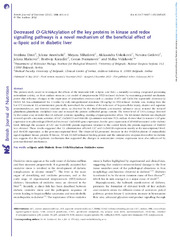Приказ основних података о документу
Decreased O-GlcNAcylation of the key proteins in kinase and redox signalling pathways is a novel mechanism of the beneficial effect of α-lipoic acid in diabetic liver
| dc.creator | Dinić, Svetlana | |
| dc.creator | Arambašić Jovanović, Jelena | |
| dc.creator | Mihailović, Mirjana | |
| dc.creator | Uskoković, Aleksandra | |
| dc.creator | Grdović, Nevena | |
| dc.creator | Marković, Jelena | |
| dc.creator | Karadžić, Borivoje | |
| dc.creator | Poznanović, Goran | |
| dc.creator | Vidaković, Melita | |
| dc.date.accessioned | 2018-11-26T14:13:31Z | |
| dc.date.available | 2018-11-26T14:13:31Z | |
| dc.date.issued | 2013 | |
| dc.identifier.issn | 0007-1145 | |
| dc.identifier.uri | http://www.ncbi.nlm.nih.gov/pubmed/23312093 | |
| dc.identifier.uri | http://www.journals.cambridge.org/abstract_S0007114512005429 | |
| dc.identifier.uri | https://radar.ibiss.bg.ac.rs/handle/123456789/3189 | |
| dc.description.abstract | The present study aimed to investigate the effects of the treatment with a-lipoic acid (LA), a naturally occurring compound possessing antioxidant activity, on liver oxidant stress in a rat model of streptozotocin (STZ)-induced diabetes by examining potential mechanistic points that influence changes in the expression of antioxidant enzymes such as catalase (CAT) and CuZn/Mn superoxide dismutase(s) (SOD). LA was administered for 4 weeks by daily intraperitoneal injections (10 mg/kg) to STZ-induced diabetic rats, starting from the last STZ treatment. LA administration practically normalised the activities of the indicators of hepatocellular injury, alanine and aspartate aminotransferases, and lowered oxidative stress, as observed by the thiobarbituric acid-reactive substance assay, restored the reduced glutathione:glutathione disulphide ratio and increased the protein sulfhydryl group content. The lower level of DNA damage detected by the comet assay revealed that LA reduced cytotoxic signalling, exerting a hepatoprotective effect. The LA-treated diabetic rats displayed restored specific enzymatic activities of CAT, CuZnSOD and MnSOD. Quantitative real-time PCR analysis showed that LA restored CAT gene expression to its physiological level and increased CuZnSOD gene expression, but the gene expression of MnSOD remained at the diabetic level. Although the amounts of CAT and CuZnSOD protein expression returned to the control levels, the protein expression of MnSOD was elevated. These results suggested that LA administration affected CAT and CuZnSOD expression mainly at the transcriptional level, and MnSOD expression at the post-transcriptional level. The observed LA-promoted decrease in the O-GlcNAcylation of extracellular signal-regulated kinase, protein 38 kinase, NF-kB, CCAAT/enhancer-binding protein and the antioxidative enzymes themselves in diabetic rats suggests that the regulatory mechanisms that supported the changes in antioxidative enzyme expression were also influenced by post-translational mechanisms. | en |
| dc.language | en | |
| dc.publisher | Cambridge University Press | |
| dc.relation | info:eu-repo/grantAgreement/MESTD/Basic Research (BR or ON)/173020/RS// | |
| dc.rights | openAccess | |
| dc.source | The British Journal of Nutrition | |
| dc.subject | alpha-Lipoic acid | |
| dc.subject | Diabetic liver | |
| dc.subject | O-GlcNAcylatio | |
| dc.subject | Oxidative Stress | |
| dc.title | Decreased O-GlcNAcylation of the key proteins in kinase and redox signalling pathways is a novel mechanism of the beneficial effect of α-lipoic acid in diabetic liver | en |
| dc.type | article | en |
| dc.rights.license | ARR | |
| dcterms.abstract | Караджић, Боривоје; Динић, Светлана; Aрамбашић, Јелена; Михаиловић, Мирјана; Ускоковић, Aлександра; Грдовић, Невена; Марковић, Јелена; Познановић, Горан; Видаковић, Мелита; | |
| dc.rights.holder | © 2013 The Authors | |
| dc.citation.issue | 3 | |
| dc.citation.volume | 110 | |
| dc.identifier.doi | 10.1017/S0007114512005429 | |
| dc.identifier.pmid | 23312093 | |
| dc.identifier.scopus | 2-s2.0-84880770415 | |
| dc.identifier.wos | 000322276800002 | |
| dc.citation.spage | 401 | |
| dc.citation.epage | 12 | |
| dc.type.version | publishedVersion | en |
| dc.identifier.fulltext | https://radar.ibiss.bg.ac.rs/bitstream/id/14621/decreased-o-glcnacylation-of-the-key-proteins-in-kinase-and-redox-signalling-pathways-is-a-novel-mechanism-of-the-beneficial-effect-of-a-lipoic-acid-in-diabetic-liver.pdf | |
| dc.citation.rank | M21 |

